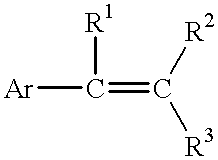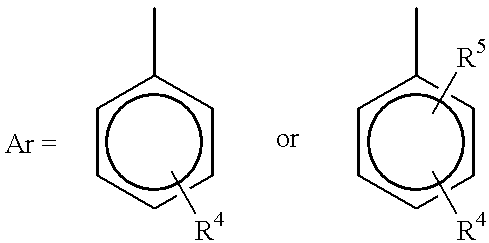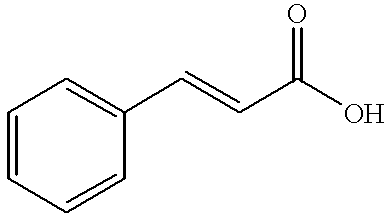Process for reducing mono-functional and non-functional by-products during aralkylation of phenolics
- Summary
- Abstract
- Description
- Claims
- Application Information
AI Technical Summary
Benefits of technology
Problems solved by technology
Method used
Image
Examples
example 1
A phenol aralkylation polymer was prepared at a total styrenic reactant:phenolic monomer mole ratio of about 1.5:1 as follows.
A stainless steel pilot plant reactor was purged with nitrogen after thoroughly cleaning with alternate solvent and caustic washes. A phenolic monomer (2274.7 g of bisphenol-A) was added to the rector under a nitrogen atmosphere and heated to a temperature of 150.degree. C. A dilute acid aralylation catalyst was prepared by dissolving methane sulfonic acid in n-butanol to obtain an MSA concentration of approximately 30 wt. %. Then, a premix of aryl diolefin and acid catalyst was made by mixing 1027 g of divinylbenzene and 1.8 g of the dilute methane sulfonic acid catalyst solution. The aryl diolefin / acid mixture then was slowly added to the melted phenolic monomer. The resultant exotherm was maintained at a temperature of 150.degree. C. Generally, the exotherm will occur within 10 minutes of catalyst addition. A 2-hour reaction period was provided after addit...
example 2
A phenol aralkylation polymer was prepared at a total styrenic reactant:phenolic monomer mole ratio of about 2:1 as follows.
Bisphenol-A was used as the phenolic monomer and divinyl benzene was used as the aryl diolefin. The styrene monomer used was para-tert-butylstyrene. Methane sulfonic acid was used as the aralkylation catalyst.
207.95 g of bisphenol-A and 145.95 of para-tert-butylstyrene were added to the rector under a nitrogen atmosphere and heated to a temperature of 120.degree. C. Next, 0.15 g of a dilute methane sulfonic acid solution (as prepared in Example 1) was added. The reaction mixture was allowed to exotherm to 130-140.degree. C. and held for 1 hour. An additional 145.95 g of para-tert-butylstyrene were added over a 60 minute period and then held at least an additional 2 hours at 130-140.degree. C.
The product thereafter was analyzed for the presence of non-functional and mono-functional by-products, and was found to contain 11,400 ppm non-functional by-products and 3...
example 3
In this example, a phenol aralkylation polymer was prepared by adding all of the para-tert-butylstyrene initially and in a total styrenic reactant: phenolic monomer mole ratio of about 2:1 as follows.
Bisphenol-A was used as the phenolic monomer and para-tert-butylstyrene was used as the styrene monomer. Methane sulfonic acid was used as the aralkylation catalyst. The styrene monomer was added in an amount of about 2 moles per mole of bisphenol-A.
207.95 g of bisphenol-A and 291.9 of para-tert-butylstyrene were added to the rector under a nitrogen atmosphere and heated to a temperature of 120.degree. C. Next, 0.15g of a dilute methane sulfonic acid solution (as prepared in Example 1) was added and the reaction mixture was allowed to exotherm to 130.degree. C., and held at 130-135.degree. C. for 3 hours.
The product thereafter was analyzed for the presence of non-functional and mono-functional by-products, and was found to contain 23,900 ppm non-functional by-products and 16,400 ppm mon...
PUM
| Property | Measurement | Unit |
|---|---|---|
| Percent by mass | aaaaa | aaaaa |
| Angle | aaaaa | aaaaa |
| Angle | aaaaa | aaaaa |
Abstract
Description
Claims
Application Information
 Login to View More
Login to View More - R&D
- Intellectual Property
- Life Sciences
- Materials
- Tech Scout
- Unparalleled Data Quality
- Higher Quality Content
- 60% Fewer Hallucinations
Browse by: Latest US Patents, China's latest patents, Technical Efficacy Thesaurus, Application Domain, Technology Topic, Popular Technical Reports.
© 2025 PatSnap. All rights reserved.Legal|Privacy policy|Modern Slavery Act Transparency Statement|Sitemap|About US| Contact US: help@patsnap.com



